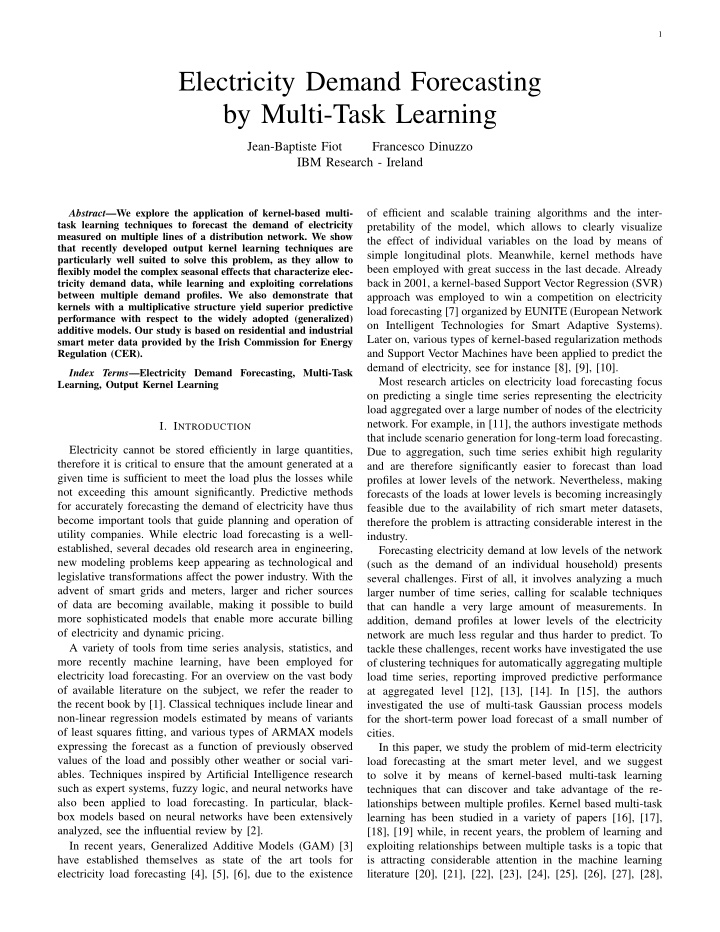



1 Electricity Demand Forecasting by Multi-Task Learning Jean-Baptiste Fiot Francesco Dinuzzo IBM Research - Ireland Abstract —We explore the application of kernel-based multi- of efficient and scalable training algorithms and the inter- task learning techniques to forecast the demand of electricity pretability of the model, which allows to clearly visualize measured on multiple lines of a distribution network. We show the effect of individual variables on the load by means of that recently developed output kernel learning techniques are simple longitudinal plots. Meanwhile, kernel methods have particularly well suited to solve this problem, as they allow to been employed with great success in the last decade. Already flexibly model the complex seasonal effects that characterize elec- back in 2001, a kernel-based Support Vector Regression (SVR) tricity demand data, while learning and exploiting correlations between multiple demand profiles. We also demonstrate that approach was employed to win a competition on electricity kernels with a multiplicative structure yield superior predictive load forecasting [7] organized by EUNITE (European Network performance with respect to the widely adopted (generalized) on Intelligent Technologies for Smart Adaptive Systems). additive models. Our study is based on residential and industrial Later on, various types of kernel-based regularization methods smart meter data provided by the Irish Commission for Energy and Support Vector Machines have been applied to predict the Regulation (CER). demand of electricity, see for instance [8], [9], [10]. Index Terms —Electricity Demand Forecasting, Multi-Task Most research articles on electricity load forecasting focus Learning, Output Kernel Learning on predicting a single time series representing the electricity load aggregated over a large number of nodes of the electricity network. For example, in [11], the authors investigate methods I. I NTRODUCTION that include scenario generation for long-term load forecasting. Electricity cannot be stored efficiently in large quantities, Due to aggregation, such time series exhibit high regularity therefore it is critical to ensure that the amount generated at a and are therefore significantly easier to forecast than load given time is sufficient to meet the load plus the losses while profiles at lower levels of the network. Nevertheless, making not exceeding this amount significantly. Predictive methods forecasts of the loads at lower levels is becoming increasingly for accurately forecasting the demand of electricity have thus feasible due to the availability of rich smart meter datasets, become important tools that guide planning and operation of therefore the problem is attracting considerable interest in the utility companies. While electric load forecasting is a well- industry. established, several decades old research area in engineering, Forecasting electricity demand at low levels of the network new modeling problems keep appearing as technological and (such as the demand of an individual household) presents legislative transformations affect the power industry. With the several challenges. First of all, it involves analyzing a much advent of smart grids and meters, larger and richer sources larger number of time series, calling for scalable techniques of data are becoming available, making it possible to build that can handle a very large amount of measurements. In more sophisticated models that enable more accurate billing addition, demand profiles at lower levels of the electricity of electricity and dynamic pricing. network are much less regular and thus harder to predict. To A variety of tools from time series analysis, statistics, and tackle these challenges, recent works have investigated the use more recently machine learning, have been employed for of clustering techniques for automatically aggregating multiple electricity load forecasting. For an overview on the vast body load time series, reporting improved predictive performance of available literature on the subject, we refer the reader to at aggregated level [12], [13], [14]. In [15], the authors the recent book by [1]. Classical techniques include linear and investigated the use of multi-task Gaussian process models non-linear regression models estimated by means of variants for the short-term power load forecast of a small number of of least squares fitting, and various types of ARMAX models cities. expressing the forecast as a function of previously observed In this paper, we study the problem of mid-term electricity values of the load and possibly other weather or social vari- load forecasting at the smart meter level, and we suggest ables. Techniques inspired by Artificial Intelligence research to solve it by means of kernel-based multi-task learning such as expert systems, fuzzy logic, and neural networks have techniques that can discover and take advantage of the re- also been applied to load forecasting. In particular, black- lationships between multiple profiles. Kernel based multi-task box models based on neural networks have been extensively learning has been studied in a variety of papers [16], [17], analyzed, see the influential review by [2]. [18], [19] while, in recent years, the problem of learning and In recent years, Generalized Additive Models (GAM) [3] exploiting relationships between multiple tasks is a topic that have established themselves as state of the art tools for is attracting considerable attention in the machine learning electricity load forecasting [4], [5], [6], due to the existence literature [20], [21], [22], [23], [24], [25], [26], [27], [28],
Recommend
More recommend